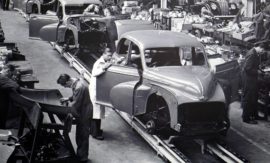Intended learning outcomes: Identify values of characteristic features for high-variety manufacturing. Explain long- and medium-term planning for manufacturing according to customer specification or of product families with many variants.
In a first attempt, we distinguish high-variety manufacturing from low-variety manufacturing. For each characteristic, the main values of certain features of planning & control, taken from Section 4.4, are shown in blue. Frequent values are shown in light blue. Figure 7.1.1.1 shows the characteristics of high-variety manufacturing, in the extreme case manufacturing according to (pure) customer specification.
Fig. 7.1.1.1 Values of characteristic features for high-variety manufacturing.
Customer tolerance time is usually long enough to manufacture all production structure levels according to customer order. Thus, products are manufactured in almost the entire supply chain according to demand, with no stockkeeping. Exceptions are general-use raw materials and purchased parts. Here, inventory is replenished as it is consumed.
In long- and medium-term planning, we can revise the generalized presentation in Figure 5.1.2.1 to make it more specialized. Not all tasks are equally important or pronounced. Figure 7.1.1.2 shows this revised form.
Fig. 7.1.1.2 Long- and medium-term planning for manufacturing according to customer specification or of product families with many variants.
- In long-term planning, a master plan does not make sense. At best, forecasts can be made for raw materials or purchased parts families.
- Forecasts for capacity are necessary, however. Blanket orders for capacity at all production structure levels of the supply chain result in improved planning power.
- An order must first be translated into a process plan for the planning of capacity, raw materials, or purchased parts families. This is usually a process network plan, such as is commonly used in project management.
- Medium-term planning is at most a fine-tuning of the long-term planning network plans for the orders.
In short-term planning & control, the tasks in Figure 5.1.3.1 are — for high-variety manufacturing — rather complex.
- For order configuration according to customer specification, first the process network plan must be refined (see, for example, Section 14.4). Raw materials or purchased parts must be made available.
- Detailed resource requirements calculation should happen quickly. Rule-based product and process configurators are used here. Generally, a multilevel order must be calculated with all its production documents, often including the drawing.
- Order coordination is required for all part orders over the supply chain, that is, over all orders for components or processes at a lower level and over several production structure levels. Generally, there is no flexibility with regard to start and completion date for part orders. Any small disturbances on the user side or in the production infrastructure of a partner have rapid repercussions within the entire supply chain
Continuation in next subsection (7.1.1b).
Course section 7.1: Subsections and their intended learning outcomes

7.1 Logistics Characteristics of a Product Variety Concept
Intended learning outcomes: Differentiate between high-variety and low-variety manufacturing. Describe different variant-oriented techniques, and the final assembly schedule.

7.1.1 High-Variety Manufacturing
Intended learning outcomes: Identify values of characteristic features for high-variety manufacturing. Explain long- and medium-term planning for manufacturing according to customer specification or of product families with many variants.

7.1.1b Low-Variety Manufacturing
Intended learning outcomes: Disclose values of characteristic features for low-variety manufacturing.

7.1.2 Different Variant-Oriented Techniques
Intended learning outcomes: Differentiate between adaptive and generative variant-oriented techniques. Disclose typical sets of characteristics and production types that arise frequently with the four product variety concepts.

7.1.2b The Final Assembly Schedule (FAS)
Intended learning outcomes: Present the concept of the final assembly schedule (FAS). Describe how the MPS concerns the highest structure level still having a small number of different items. Identify FAS/MPS/OPP patterns in dependency on the product variety concept and their relation to the patterns of the T analysis.
